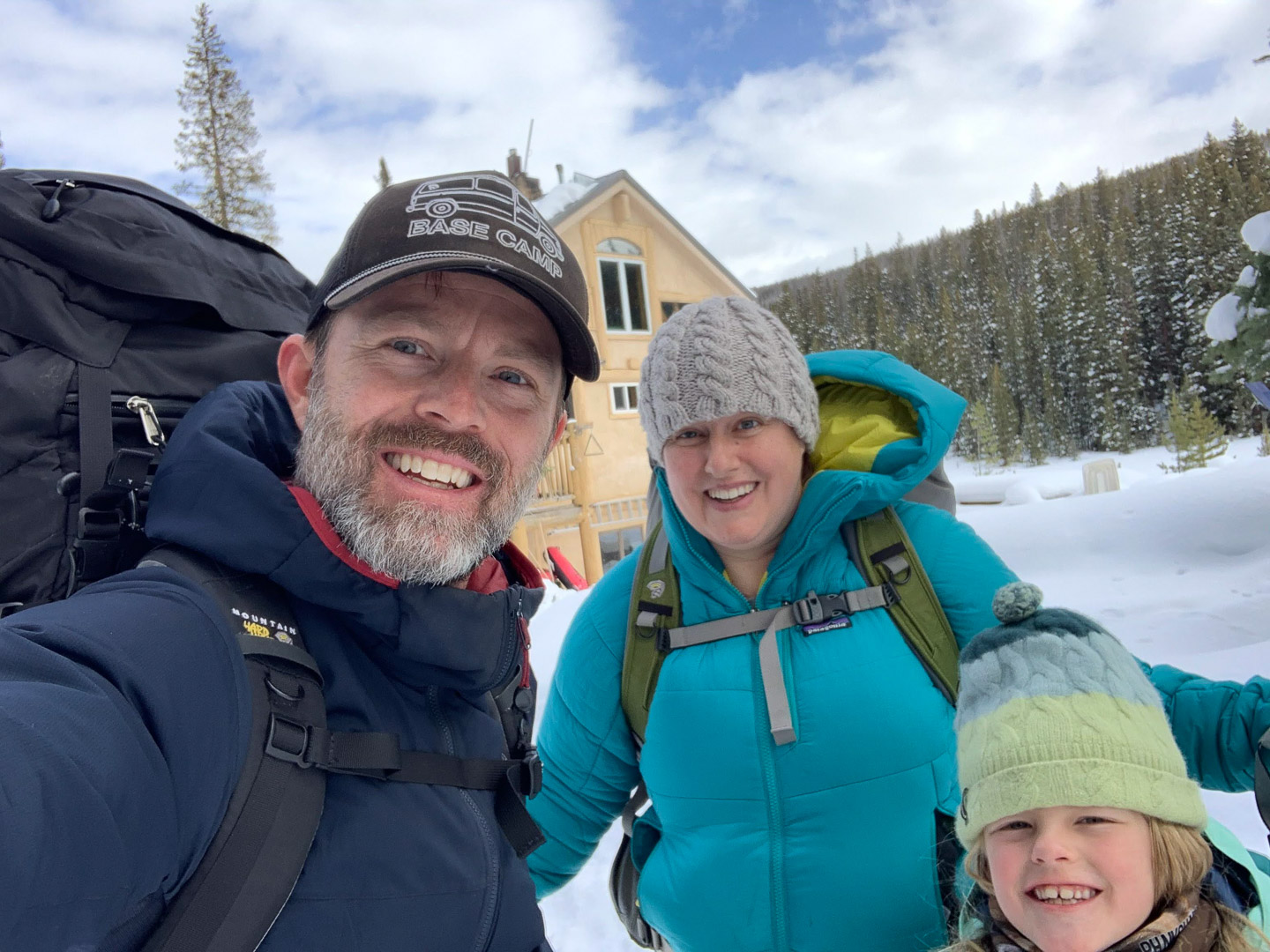
From the Cascade Hut trail in Oregon and the 10th Mountain Division Hut Association in Colorado to the AMC huts in New Hampshire and Maine Huts & Trails, outdoor adventurers head out to huts in the winter for solace, incredible recreation opportunities and a chance to enjoy the company of family and friends. Booking a winter hut trip takes advance preparation, while gearing up for the trip takes organization and planning. These seven tips will help you if you ever have the desire to adventure out in the winter snow for a night, or a few nights, in a hut.

Choose A Simple Hut
While the huts in Europe are plentiful, the United States has a limited hut system. This means you will need to plan your trip well in advance, especially if you are planning to go on a weekend. Huts require reservations, typically about six months in advance. Some hut systems (like the 10th Mountain Division) allow members to request hut dates via lottery before dates open to the general public.
For your first hut trip, there is no reason to choose a technical and long route. Keep it simple with short mileage and flatter terrain. “Before you head out, know the route options and your group’s abilities and fitness levels,” suggested Erin Brosterhous, founder of Blue Fire Collective, who has done 20 or so hut trips over the years. Oftentimes, there might be multiple routes you can take to the hut, so plan the one that gets you there the fastest and safest.
Hut amenities will vary. Some private huts offer luxuries like running water, showers and even saunas or hot tubs; some are more primitive. Consider things like if you want the task of collecting snow for water or if you want to keep it simpler. Do you want to avoid having to worry about avalanche danger? Choose a hut that has less risk of avalanche based on the terrain.
Other considerations are whether you want to share a hut with other parties or if you want the hut to yourself. COVID-19 restrictions often mean only one party will be allowed per hut, but that may change back to pre-COVID-19 policies. Sharing a hut with other parties often cuts down on the cost.
Head to the pages for 10th Mountain Division Hut Association, AMC Huts, or the to start your planning. Private huts can typically be found by searching within the desired state.

Pack Smart
Hut amenities will vary by location, so check what is provided in the hut and what isn’t as your starting point for packing. Current COVID-19 restrictions may mean you need to pack additional items that are typically available at the hut, including towels. Also, don’t take the hut trip as an opportunity to test new gear. You will want to do that in advance to make sure everything works properly and your gear fits correctly.
Huts have a heat source, but many have a heat source that must be maintained through the day and night. The biggest item you will need to pack is a sleeping bag with a good temperature rating for the cold nights. The sleeping bag should go at the bottom of the pack.
Just like with any winter activity, layers are the name of the game. You will want a breathable base layer, an insulating layer and a waterproof shell. Bring an extra base layer and insulating layer (depending on length of stay) and plenty of clean socks, as well. You will want to be sure to change these items out over the days you are at the hut.
Since your hut will most likely be at a higher elevation than where you live, hydration is key. Carrying a bladder filled for the trip in and out and packing some electrolyte packets is a definite must.
Choose one person to carry repair supplies, from duct tape and rope to extra screws and a multitool, just in case something happens while you are in the middle of nowhere. Another can carry a first-aid kit for the unexpected. These items, snacks and removable layers should be packed at the top.
Don’t forget creature comforts, like slippers, and a few luxuries, like a good bottle or two of wine. A small speaker to play some music while chilling by the fire and/or a favorite or new book can go a long way for relaxation time. Some huts have games, books, puzzles and other activities on-site. Check the specific list for your hut to see what they have on hand. If there is a game you love to play, make sure it gets put into your pack. “Card games and cribbage are hut necessities for us,” added Brosterhous.
More than likely, cell service will be spotty at best, so download or print out a route map before you head for the hut. You will also want a compass for use with your map. Consider pulling along a Chariot or other trailer, a sled or even a pulk to haul gear (and maybe a kid or two). A sled can also be used for some snow play fun when you get to the hut.
Heavy items should be stored in your pack in the middle against your back. This way, carrying the load will be easier on your body. “In the end, less is more,” said Brosterhous, remembering the many trips she has taken.

Meal Plan
In the winter months, it takes more energy to keep your body warm. Plus, the workout you put in getting to and from the hut will burn a lot of calories. Foods that offer fast calories and that are higher in fat are the best choices.
If you have a group, the best advice is to pack your own lunches and snacks and share the responsibility of breakfasts and dinners. “I am a big fan of lunches/snacks on your own and breaking into groups of three to four to haul in and execute dinners and breakfasts,” said Brosterhous.
Precut fruits and veggies, and take food items out of packages to save weight and room. You can precook meat or prepare soups, breakfast burritos and other items ahead of time to cut down on ingredients, prep and cooking time. However you break it down, those who are responsible for each meal should be in charge of hauling in that food, cooking it, cleaning up and hauling out any leftovers.

Start Out Early
Experienced hut-goers know that you want to get an early start to the hut based on distance and even check-in time. It is better to get there early and be able to have some fun in the snow than to be trying to find the hut under darkness and in the cold. If the hut you are traveling to is far away, consider staying in a hotel closer to the hut to get an early start.
However fast you can hike a certain distance, expect it to take at least double that time through the snow. Whether you snowshoe or ski, you will be carrying a heavy load, as well. “Plan to be at the trailhead no later than 8 a.m.,” said Brosterhous, who does hut trips in the longer mileage range. “It always takes longer to pack up at the parking lot than you want,” she added.

Play It Safe
Huts are often found in areas that are within avalanche territory. Continue to check the weather leading up to your trip and make any adjustments necessary, including leaving earlier or checking if you can change dates if the avalanche danger is superhigh. “Know the [avalanche] conditions [and] trends and watch the CAIC or other [avalanche] report for a few weeks prior to departure,” suggested Brosterhous.
Everyone in your party should carry a headlamp. At least one to two people in your party should be carrying avalanche gear in case of an emergency. It is also important that you are with someone who is trained in what to do if an avalanche occurs. If you are headed to avalanche territory, refresh yourself about avalanche safety and rescue protocols. A good resource to start with is Avalanche.org for conditions and safety tips.
If you are heading to the hut in a group, everyone should have the hut code written down on paper in their packs. A good safety tip is to let those in your party know how you are feeling throughout the route. Monitor for signs of altitude sickness, including headaches and shortness of breath. The group should stick together as a general rule of thumb so no one is separated from someone with avalanche safety gear, a map and a compass.
Make sure someone not within your party knows the location you are headed to. You should also let them know the date and approximate time you will return.

Assign Hut Chores
From chopping wood to continuing to fuel the fire, hut chores are a big part of the stay. “I believe that hut chores are fun, and engaging in the work makes the experience,” said Brosterhous.
Having a hut leader assigned before the trip is a good plan. This person is in charge of the paperwork (including signing waivers), payment for the hut and the logistics, like check-in time, the lockbox code and maybe even the route map. Shuttling or carpooling to the trailhead may also be a logistic the leader should take on, as well as if your party will stay in a hotel the night before.
Meal prep, cooking and cleanup will already be assigned if you planned ahead. One large job is collecting snow for water if no plumbing is available at the hut. If you are gathering snow for melting water, you will need to collect snow at least 20 yards from the hut. Be sure to choose clean snow untouched by humans or animals. When collecting snow, you should use gloves. Melt the snow first, and then filter it to be sure it is clean.
The first thing to do when you reach the hut is to have someone be in charge of clearing snow off the deck. The hut entrance needs to be clear of snow, as well.
Some huts will already have wood prechopped, while at others you may have to chop wood to keep the fire fueled. Large logs will need to be split, as smaller and thinner pieces work best in a wood-burning stove. You may want to set up shifts for keeping the fire going through the night.
Sweeping the hut to make sure it stays clean is a job that will need to be completed multiple times a day. Assign a sweeper to maintain the hut. Keeping up with sweeping will also be a big help when it is time to leave the hut for the next party to enjoy.
Being in charge of your own gear and keeping it organized is a hut chore that everyone should take on. Be cognizant of where you are drying your wet gear. “Keep your own stuff organized, and stow/dry your gear out in places that don’t impact the group,” suggested Brosterhous.
Be sure to follow all the hut closing guidelines, from what to do with trash to whether to keep the fire burning. More than likely, another party will be enjoying the hut right after you, so be sure to leave the hut nicer than when you first got there. “The strongest skiers should offer to haul out the trash,” said Brosterhous.

Have Fun
Spending a night or a few in a hut is the ultimate winter experience. The silence, the coziness and the adventure to be had make it so worth the planning, prep and execution. “It’s just superfun to hike in and be in the mountains with your friends and family,” said Brosterhous. The best hut trips are the ones where everyone pitches in, everyone stays safe and everyone leaves with plenty of stories and with cheeks that hurt from all the smiling and laughing. “Safety is fun, so sometimes you just build kickers, read and play games if the [avalanche] danger is high,” Brosterhous added.





